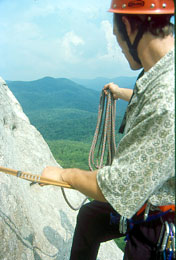Climbing Ropes
|
Rope Construction: Climbing ropes are classified as either static or dynamic.Both types are made using a kermantel construction. Kernmantel ropes are made of braided or parallel nylon filaments, surrounded by a smooth, woven sheath of nylon for protection. Static Ropes: Static ropes are primarily used for resucue work, repelling, and caving. They stretch very little and are not good at absorbing the energy of a falling climber. Thus, static ropes should not be used for rock climbing. Dynamic Ropes: A dynamic rope is the most appropraite type of rope for rock climbing. It is designed to elongate under a load to absorb some of the energy of a falling climber. This reduces the impact force on the climber, belayer, and the anchors. Most U.S. climbers use a single 10.5mm to 11mm diamter rope. Pre-cut ropes come in 50, 60, and 70 meter lengths.
|
|
 |
Standards: Any climbing rope worth using will meet the standards set out by the UIAA (Union Internationale Des Association D'Apinisme).In order to meet the minimum UIAA standard, ropes must exhibit less than 12 kN impact force, this is the maximum amount of force that can be transmitted to a falling climber. The static elongation of a rope cannot exceed 8%. This is the amount a rope stretches with an 80 kg weight statically fixed to one end. It must also be able to hold at least five test falls (fall factor 1.78) a using an 80kg weight without breaking.
|
|
